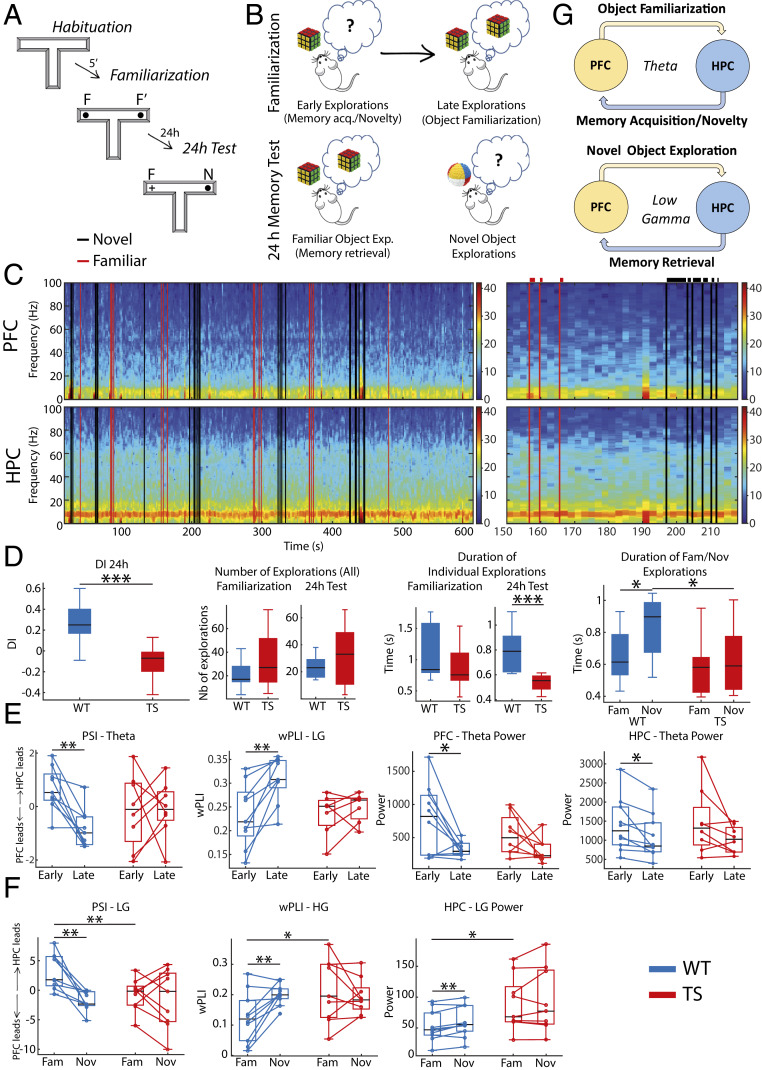Fig. 3.
Neural signals that develop during object familiarization and retrieval in WT mice are disrupted in Ts65Dn mice. (A) The novel object recognition task consists of three phases of 10 min each. 1) Habituation phase: Mice first explore an empty maze. 2) Familiarization phase: Mice explore two identical objects placed at the end of the lateral arms of the maze. During this phase memory for the presented object is first acquired and then stored into memory. 3) Twenty-four-hour memory test: Mice explore two objects; one is familiar (presented the previous day), and the other is novel, with the arm chosen randomly in each session. During this phase the memory for the familiar object is retrieved from memory. (B) Schematic diagram illustrating memory acquisition and familiarization over multiple explorations of objects during the familiarization phase and memory retrieval when recognizing a familiar object during the 24 h memory test. (C) Example spectrogram of a 24 h memory test session of a WT mouse. Black and red lines represent the onset of individual explorations of novel and familiar objects, respectively, detected during the recording session via a video camera and aligned to the electrophysiology system via button presses on a joystick. An amplification of 70 s of the recording is also shown where the duration of each visit is illustrated on top of each line. (D) DIs were smaller in Ts65Dn mice compared to their WT littermates during the 24 h memory test. TS mice tended to visit the objects on more occasions than WT mice, during both the familiarization and test phases, but the explorations were shorter, particularly for novel objects in the test phase. Thus, smaller DIs in Ts65Dn mice resulted from shorter explorations of novel objects despite the increased number of visits. (E) Neural activities associated with memory acquisition and familiarization. Shown are neural signals recorded during the first 5 s (early) vs. the last 5 s (late) explorations of the two identical objects (ordered in time). In WT mice but not Ts65Dn mice, PFC to HPC theta connectivity and PFC-HPC low gamma phase synchronization strengthened as items were stored into memory (late visits). By contrast, theta power in PFC and HPC decreased. (F) Neural activities associated with memory retrieval. Shown are neural signals recorded during all explorations of the familiar and novel objects in one session. In WT mice but not Ts65Dn mice, HPC to PFC low gamma connectivity strengthens as items are retrieved from memory. This is accompanied by weakening of PFC-HPC high gamma phase synchronization and HPC low gamma power. (G) Proposed contribution of PFC-HPC circuits to memory acquisition, familiarization, and retrieval in the NOR task in WT mice. The quantification of all neural signals recorded during the NOR task in WT and TS mice is summarized in SI Appendix, Tables S3 and S4. *P ≤ 0.05, **P ≤ 0.01, ***P ≤ 0.001.

